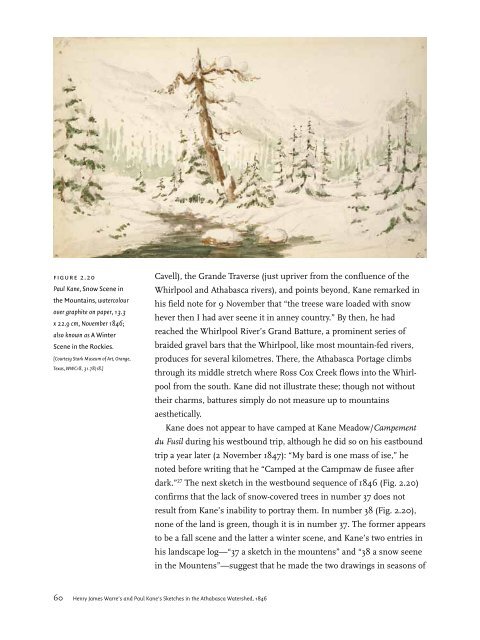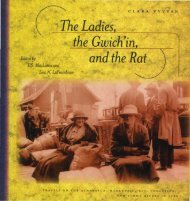Henry James Warre's and Paul Kane's Sketches in the Athabasca ...
Henry James Warre's and Paul Kane's Sketches in the Athabasca ...
Henry James Warre's and Paul Kane's Sketches in the Athabasca ...
You also want an ePaper? Increase the reach of your titles
YUMPU automatically turns print PDFs into web optimized ePapers that Google loves.
figure 2.20<strong>Paul</strong> Kane, Snow Scene <strong>in</strong><strong>the</strong> Mounta<strong>in</strong>s, watercolourover graphite on paper, 13.3x 22.9 cm, November 1846;also known as A W<strong>in</strong>terScene <strong>in</strong> <strong>the</strong> Rockies.[Courtesy Stark Museum of Art, Orange,Texas, WWC18, 31.78/18.]Cavell), <strong>the</strong> Gr<strong>and</strong>e Traverse (just upriver from <strong>the</strong> confluence of <strong>the</strong>Whirlpool <strong>and</strong> <strong>Athabasca</strong> rivers), <strong>and</strong> po<strong>in</strong>ts beyond, Kane remarked <strong>in</strong>his field note for 9 November that “<strong>the</strong> treese ware loaded with snowhever <strong>the</strong>n I had aver seene it <strong>in</strong> anney country.” By <strong>the</strong>n, he hadreached <strong>the</strong> Whirlpool River’s Gr<strong>and</strong> Batture, a prom<strong>in</strong>ent series ofbraided gravel bars that <strong>the</strong> Whirlpool, like most mounta<strong>in</strong>-fed rivers,produces for several kilometres. There, <strong>the</strong> <strong>Athabasca</strong> Portage climbsthrough its middle stretch where Ross Cox Creek flows <strong>in</strong>to <strong>the</strong> Whirlpoolfrom <strong>the</strong> south. Kane did not illustrate <strong>the</strong>se; though not without<strong>the</strong>ir charms, battures simply do not measure up to mounta<strong>in</strong>saes<strong>the</strong>tically.Kane does not appear to have camped at Kane Meadow/Campementdu Fusil dur<strong>in</strong>g his westbound trip, although he did so on his eastboundtrip a year later (2 November 1847): “My bard is one mass of ise,” henoted before writ<strong>in</strong>g that he “Camped at <strong>the</strong> Campmaw de fusee afterdark.” 27 The next sketch <strong>in</strong> <strong>the</strong> westbound sequence of 1846 (Fig. 2.20)confirms that <strong>the</strong> lack of snow-covered trees <strong>in</strong> number 37 does notresult from Kane’s <strong>in</strong>ability to portray <strong>the</strong>m. In number 38 (Fig. 2.20),none of <strong>the</strong> l<strong>and</strong> is green, though it is <strong>in</strong> number 37. The former appearsto be a fall scene <strong>and</strong> <strong>the</strong> latter a w<strong>in</strong>ter scene, <strong>and</strong> Kane’s two entries <strong>in</strong>his l<strong>and</strong>scape log—“37 a sketch <strong>in</strong> <strong>the</strong> mountens” <strong>and</strong> “38 a snow seene<strong>in</strong> <strong>the</strong> Mountens”—suggest that he made <strong>the</strong> two draw<strong>in</strong>gs <strong>in</strong> seasons of60 <strong>Henry</strong> <strong>James</strong> Warre’s <strong>and</strong> <strong>Paul</strong> Kane’s <strong>Sketches</strong> <strong>in</strong> <strong>the</strong> <strong>Athabasca</strong> Watershed, 1846
















